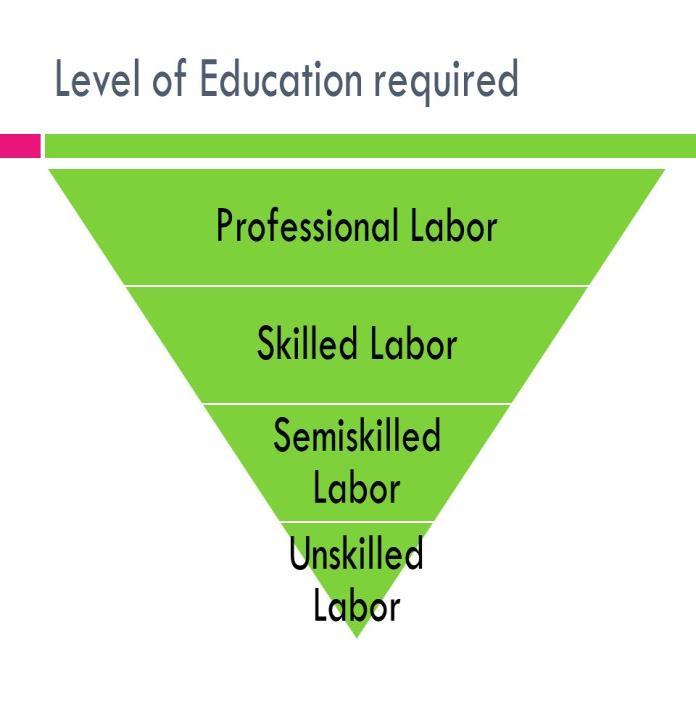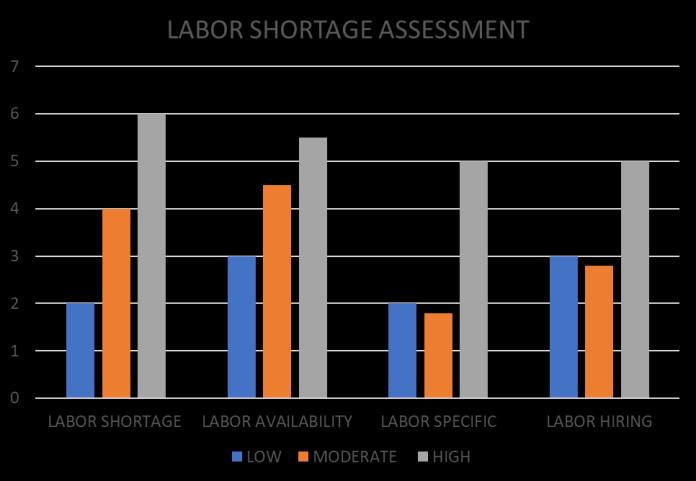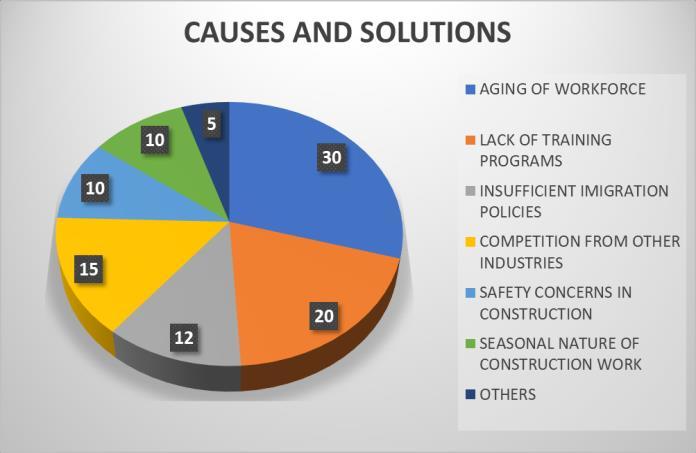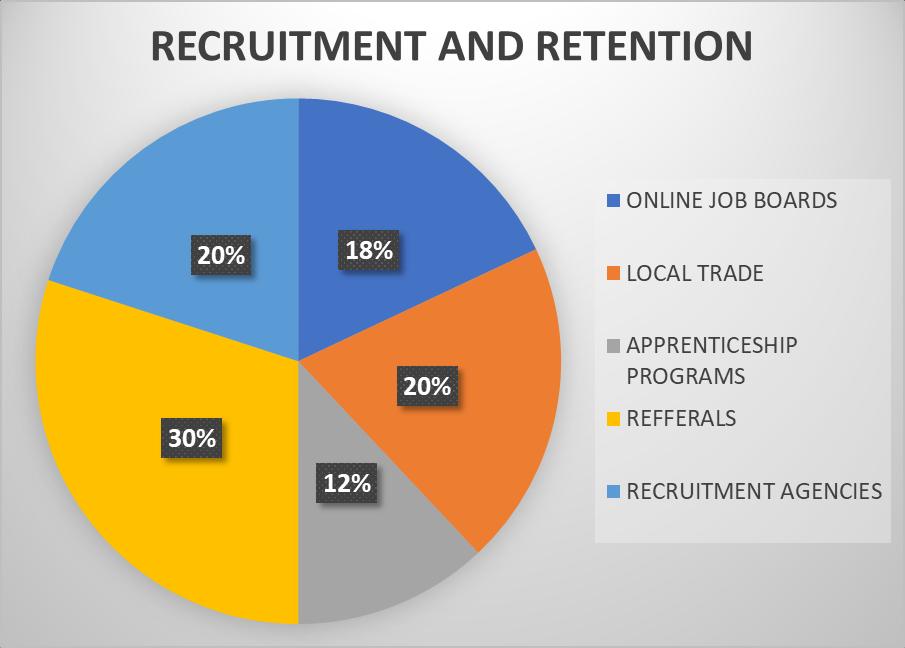
International Research Journal of Engineering and Technology (IRJET) e-ISSN: 2395-0056
Volume: 11 Issue: 12 | Dec 2024 www.irjet.net p-ISSN: 2395-0072


International Research Journal of Engineering and Technology (IRJET) e-ISSN: 2395-0056
Volume: 11 Issue: 12 | Dec 2024 www.irjet.net p-ISSN: 2395-0072
Ar.Rakesh J1 , Ar.Vidya Naveen 2 .
1Student, Dr.M.G.R University, Chennai, Tamilnadu, India.
2Professor, Dr.M.G.R University, Chennai, Tamilnadu, India.
Abstract - I wanted to share some insights about the constructionindustry'sroleintheeconomyandthechallenges it faces regarding skilled labor shortages impacting quality management. It's fascinating how various factors like demographic shifts, limited vocational training, and competition from emerging sectors exacerbate these shortages. As a result, there's a noticeable decline in overall quality, affecting project timelines, safety, and stakeholder satisfaction. The research I came across delves deep into this relationship between labor shortages and quality management. It highlights the complexities faced by contractors, such as increased workloads, subcontracting issues, and reliance on less skilled workers, leading to errors, safety incidents, and project delays. The study also discusses strategieslikeinvestingintrainingandtechnologytooptimize resources and enhance productivity amongskilled labor
Key Words: Constructionindustry,skilledlabours,quality management, labour shortages, labour availability, safety practices.
Theconstructionindustry,acornerstoneofglobaleconomic growthandinfrastructuredevelopment,facesasignificant challenge: the shortage of skilled labor. This issue has become increasingly pressing, with profound implications forqualitymanagementwithinthesector.Theskilledlabor deficit not only hampers project timelines and increases costsbutalsocompromisesthestandardsandreliabilityof construction outputs. As the demand for construction services escalates due to urbanization and population growth,thegapbetweentheneedforskilledworkersand their availability continues to widen, exacerbating quality managementconcerns.
Quality management in construction is a multifaceted process encompassing planning, control, assurance, and improvement to meet project specifications and client expectations. It relies heavily on the expertise and proficiency of the workforce. Skilled laborers, including tradespeople,technicians,andsitemanagers,playacritical roleinensuringthatconstructionprojectsadheretosafety regulations, design specifications, and performance standards. Their knowledge and experience are indispensableinidentifyingpotentialissues,implementing
best practices, and maintaining the integrity of the built environment.
Thescarcityofskilledlabourhasbeenattributedtovarious factors,includinganaging workforce, insufficient training programs, and a declining interest in construction trades among younger generations. Additionally, economic fluctuationsandmigrationpatternsfurthercomplicatethe availabilityofskilledworkers.Thisshortageleadstoseveral quality-related challenges, such as increased defect rates, rework, and safety hazards, which collectively undermine theoverallprojectoutcomes.
Giventhesedynamics,itiscrucialtoexploretheimpactof skilled labour shortages on quality management in construction.Thispaperaimstoinvestigatetherelationship between workforce deficits and quality performance, identifyingkeyareaswherethelackofskilledpersonnelis most detrimental. By analysing case studies, industry reports, and empirical data, this study seeks to provide a comprehensiveunderstandingofthecurrentlandscapeand proposestrategicsolutionstomitigatetheadverseeffectson qualitymanagement.
Understanding the interplay between skilled labour availability and quality management is essential for stakeholdersintheconstructionindustry.Addressingthis issuenotonlyenhancesprojectoutcomesbutalsoensures thesustainabilityandresilienceoftheconstructionsectorin thefaceofongoingchallenges.
The construction industry is a critical sector for economic development,infrastructure,andemployment.However,it faces persistent challenges, among which skilled labor shortagesareparticularlydetrimental.Theseshortagesaffect various aspects of construction projects, including cost, schedule, and quality management. This literature review synthesizescurrentresearchontheimpactofskilledlabor shortages on quality management within the construction industry,highlightingthescope,causes,consequences,and potential mitigation strategies. Quality management in constructionreferstothecoordinatedactivitiestodirectand control the quality of the construction process and its outcomes, ensuring that projects meet specified requirements and standards. Skilled labor is defined as

International Research Journal of Engineering and Technology (IRJET) e-ISSN: 2395-0056
Volume: 11 Issue: 12 | Dec 2024 www.irjet.net p-ISSN: 2395-0072
workers
1.2.1 Compromised
Skilledlaborshortagesoftenleadtoa situationwhere workers with inadequate training or experience are taskedwithcriticalconstructiontasks.Thiscanresultin compromisedworkmanship,leadingtodefects,errors, andinconsistenciesinthefinalproduct.
Qualitymanagementreliesontheskillsandexpertiseof workerstoadheretoprecisespecificationsandindustry standards. When skilled workers are scarce, the likelihoodofmistakesandsubparworkincreases
1.2.2
In an environment where there aren't enough skilled workers,theexistingworkforcemaybestretchedthinto completetaskswithintightdeadlines.Thiscanleadto increasedworkloadandfatigueamongworkers,whichin turncannegativelyimpacttheirattentiontodetailand abilitytoadheretoqualitycontrolmeasures.
Fatiguedworkersaremorepronetomakingerrorsand overlookingimportantqualitychecks.
1.2.3 Limited Supervision and Training:
Skilledlaborshortagescanalsostraintheavailabilityof experienced supervisors and trainers. New or less experienced workers may not receive adequate guidance, training, and oversight, leading to a lack of awarenessaboutqualitystandardsandbestpractices.
• Effective quality management requires ongoing trainingandmentorshiptoensurethatallworkers understandandfollowestablishedqualityprotocols.
1.2.4 Delays and Cost Overruns:
Theshortageofskilledlaborcanleadtoprojectdelaysas tasks take longer to complete due to a reduced workforce. Delays can result in increased costs due to extended project durations, potential penalties for missing deadlines,and additional expenses toaddress reworkcausedbyqualityissues.
Qualitymanagementeffortscanbecompromisedasthe pressuretocompleteprojectsontimeintensifies.
1.2.5 Diminished Client Satisfaction:
Quality management is closely linked to client satisfaction.Whenskilledlaborshortagescontributeto
defects,delays,andcostoverruns,clients'expectations maynotbemet.
Thiscanleadtodissatisfaction,strainedclient-contractor relationships, and potential damage to a construction company


1.3 SUMMARY OF THE PROJECT
Even if the site follows certain terms and conditions on qualityaspects,theymustfocusonsupervisionandskilled laborersontheirupcomingprojects.
Goodqualityofmaterialsandfinishensuresagoodlifespan ofthestructureandsustainsoveralongperiod.
Testingandinspectionofmaterialsmustbedoneagainatthe site.
Records and interim reports are not maintained properly here.

International Research Journal of Engineering and Technology (IRJET) e-ISSN: 2395-0056
Volume: 11 Issue: 12 | Dec 2024 www.irjet.net p-ISSN: 2395-0072
Thequalityofthematerialsmustbeimproved.
Inthecurrentscenario,MLCPisinprogress.
Theclubhouseandcommercialisyettobefinished.
The site transformer and control panel board have to be installed.
Thesitesurroundingpavementworksisunderprogress.
BrigadeXanadu,Mogappairhas11towers,with6floorseach and944unitsonoffer.
BrigadeXanaduisaSpanish-inspiredarchitecture

1.4 SUMMARY OF THE PROJECT
All the quality aspects regarding the various stages of construction in a residential project were studied and implementedonthesite.
Toomucherrorswerenotdiscovered.
Sitelaboratoryisinstalledonthesiteforthematerialssuch asprecastconcreteblock,barbending,etc.
Continuous assessments regarding quality check and maintenance were checked regularly from day-to-day activities.
IS Standards for all the materials, resources, and quality checkswerefollowed.
Betterteamcollaborationonthesite.
Safetyonthesiteforworkerswasmaintainedproperly.

Chart-1:Laborshortageassessment
Theconstructionindustry'slaborshortageisacomplexissue that requires immediate attention from both industry leaders and policymakers. By implementing targeted educational programs, offering incentives for hiring, and improvingworkingconditions,itmaybepossibletoattracta newgenerationofskilledworkersessential forsustaining growthinthiscriticalsector.
2.1

Chart-2:Laborshortage:causesandsolutions
By addressing these underlying causes through targeted solutions, the construction industry can work towards alleviating its current labor shortages and ensuring a sustainableworkforceforthefuture.

International Research Journal of Engineering and Technology (IRJET) e-ISSN: 2395-0056
Volume: 11 Issue: 12 | Dec 2024 www.irjet.net p-ISSN: 2395-0072

The construction industry's recruitment and retention of laborpresentsignificantchallengesthatrequireinnovative solutions.Byadoptingeffectiverecruitmentstrategiesand fostering a supportive work environment, construction companies can better attract and retain skilled workers. Addressing these issues not only enhances workforce stability but also contributes to the overall success of the industryasitnavigatesongoinggrowthdemands.
Theimpactofskilledlaborshortagesonqualitymanagement intheconstruction industry issignificant. Addressingthis crisisrequiresamulti-facetedapproachinvolvingimproved training, better working conditions, and innovative use of technology.Bytacklingtheseissueshead-on,stakeholders canenhanceprojectoutcomesandensurethesustainability oftheconstructionsectorinthefaceofongoingchallenges.
Provide practical recommendations for construction companiesandpolicymakers.
Emphasizetheneedforacollaborativeapproachtotackling laborshortagesandimprovingqualitymanagement.
Not only on skilled laborers, they should focus on supervisionalso.Eventhesupervisormustbeskilledenough tohandletheworkscarriedoutontheconstructionsite.
Even site follows certain IS standards and codes during construction, all the materials should be tested and inspected periodically and that are documented by the projectmanagerortheheadsupervisor.
Teamworkandgoodcommunicationbetweentheemployees withoutmisunderstandinggiveagoodqualityoutcome.
The construction industry is a critical sector with a direct impactoneconomicgrowthandsocietaldevelopment.The availabilityofskilledlaborplaysapivotalroleinensuring the quality and sustainability of construction projects. Skilled labor shortages are a widespread issue in the construction industry, with various factors, including demographic changes and insufficient training programs, contributing to this problem. These shortages can lead to delays, increased costs, and compromised quality in constructionprojects.Qualitymanagementinconstruction involves a range of processes and standards aimed at ensuring that projects meet specifications, are safe, and comply with regulations. The impact of skilled labor shortages on quality management in the construction industry is evident through case studies and statistical evidence.Projectswithadequateskilledlabortendtohave betterqualityoutcomescomparedtothoseaffectedbylabor shortages.
[1] http://www.sciencepublishinggroup.com/j/ajce
[2] https://www.sciencedirect.com/science/article/pii/S08 8539241730475X
[3] https://www.ilo.org/global/industries-andsectors/construction
[4] http://www.sciencepublishinggroup.com/j/ajce